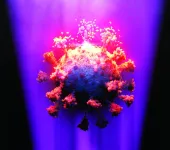(Press-News.org) CAMBRIDGE, MA -- Sequencing all of the RNA in a cell can reveal a great deal of information about that cell’s function and what it is doing at a given point in time. However, the sequencing process destroys the cell, making it difficult to study ongoing changes in gene expression.
An alternative approach developed at MIT could enable researchers to track such changes over extended periods of time. The new method, which is based on a noninvasive imaging technique known as Raman spectroscopy, doesn’t harm cells and can be performed repeatedly.
Using this technique, the researchers showed that they could monitor embryonic stem cells as they differentiated into several other cell types over several days. This technique could enable studies of long-term cellular processes such as cancer progression or embryonic development, and one day might be used for diagnostics for cancer and other diseases.
“With Raman imaging you can measure many more time points, which may be important for studying cancer biology, developmental biology, and a number of degenerative diseases,” says Peter So, a professor of biological and mechanical engineering at MIT, director of MIT’s Laser Biomedical Research Center, and one of the authors of the paper.
Koseki Kobayashi-Kirschvink, a postdoc at MIT and the Broad Institute of Harvard and MIT, is the lead author of the study, which appears today in Nature Biotechnology. The paper’s senior authors are Tommaso Biancalani, a former Broad Institute scientist; Jian Shu, an assistant professor at Harvard Medical School and an associate member of the Broad Institute; and Aviv Regev, executive vice president at Genentech Research and Early Development, who is on leave from faculty positions at the Broad Institute and MIT’s Department of Biology.
Imaging gene expression
Raman spectroscopy is a noninvasive technique that reveals the chemical composition of tissues or cells by shining near-infrared or visible light on them. MIT’s Laser Biomedical Research Center has been working on biomedical Raman spectroscopy since 1985, and recently, So and others in the center have developed Raman spectroscopy-based techniques that could be used to diagnose breast cancer or measure blood glucose.
However, Raman spectroscopy on its own is not sensitive enough to detect signals as small as changes in the levels of individual RNA molecules. To measure RNA levels, scientists typically use a technique called single-cell RNA sequencing, which can reveal the genes that are active within different types of cells in a tissue sample.
In this project, the MIT team sought to combine the advantages of single-cell RNA sequencing and Raman spectroscopy by training a computational model to translate Raman signals into RNA expression states.
“RNA sequencing gives you extremely detailed information, but it’s destructive. Raman is noninvasive, but it doesn’t tell you anything about RNA. So, the idea of this project was to use machine learning to combine the strength of both modalities, thereby allowing you to understand the dynamics of gene expression profiles at the single cell level over time,” Kobayashi-Kirschvink says.
To generate data to train their model, the researchers treated mouse fibroblast cells, a type of skin cell, with factors that reprogram the cells to become pluripotent stem cells. During this process, cells can also transition into several other cell types, including neural and epithelial cells.
Using Raman spectroscopy, the researchers imaged the cells at 36 time points over 18 days as they differentiated. After each image was taken, the researchers analyzed each cell using single molecule fluorescence in situ hybridization (smFISH), which can be used to visualize specific RNA molecules within a cell. In this case, they looked for RNA molecules encoding nine different genes whose expression patterns vary between cell types.
This smFISH data can then act as a link between Raman imaging data and single-cell RNA sequencing data. To make that link, the researchers first trained a deep-learning model to predict the expression of those nine genes based on the Raman images obtained from those cells.
Then, they used a computational program called Tangram, previously developed at the Broad Institute, to link the smFISH gene expression patterns with entire genome profiles that they had obtained by performing single-cell RNA sequencing on the sample cells.
The researchers then combined those two computational models into one that they call Raman2RNA, which can predict individual cells’ entire genomic profiles based on Raman images of the cells.
Tracking cell differentiation
The researchers tested their Raman2RNA algorithm by tracking mouse embryonic stem cells as they differentiated into different cell types. They took Raman images of the cells four times a day for three days, and used their computational model to predict the corresponding RNA expression profiles of each cell, which they confirmed by comparing it to RNA sequencing measurements.
Using this approach, the researchers were able to observe the transitions that occurred in individual cells as they differentiated from embryonic stem cells into more mature cell types. They also showed that they could track the genomic changes that occur as mouse fibroblasts are reprogrammed into induced pluripotent stem cells, over a two-week period.
“It’s a demonstration that optical imaging gives additional information that allows you to directly track the lineage of the cells and the evolution of their transcription,” So says.
The researchers now plan to use this technique to study other types of cell populations that change over time, such as aging cells and cancerous cells. They are now working with cells grown in a lab dish, but in the future, they hope this approach could be developed as a potential diagnostic for use in patients.
“One of the biggest advantages of Raman is that it’s a label-free method. It’s a long way off, but there is potential for the human translation, which could not be done using the existing invasive techniques for measuring genomic profiles,” says Jeon Woong Kang, an MIT research scientist who is also an author of the study.
###
The research was funded by the Japan Society for the Promotion of Science Postdoctoral Fellowship for Overseas Researchers, the Naito Foundation Overseas Postdoctoral Fellowship, the MathWorks Fellowship, the Helen Hay Whitney Foundation, the U.S. National Institutes of Health, the U.S. National Institute of Biomedical Imaging and Bioengineering, HubMap, the Howard Hughes Medical Institute, and the Klarman Cell Observatory.
END
Noninvasive technique reveals how cells’ gene expression changes over time
MIT researchers can now track a cell’s RNA expression to investigate long-term processes like cancer progression or embryonic development
2024-01-10
ELSE PRESS RELEASES FROM THIS DATE:
Rice scientists use blood test to track gene expression in the brain
2024-01-10
HOUSTON – (Jan. 10, 2023) – The brain is the most protected organ in the body, sheathed in a complex and nearly impenetrable barrier of specialized blood vessels. While this particular anatomical setup protects it from outside invaders, it also makes it difficult for researchers to study how specific genes are expressed ⎯ and how such changes in gene expression may lead to disease.
Now Rice University scientists have developed a noninvasive way to monitor gene expression dynamics in the brain, making it easier to investigate brain ...
Unravelling individual differences in DNA mutation risks
2024-01-10
Barcelona, 10 January 2024 – Mutations, which occur continuously in every cell of our bodies, are a key contributor to cancer, ageing, and neurodegeneration. While exposure to mutagenic chemicals, or mistakes in cellular processes during DNA replication contribute to these mutations, the exact distribution and patterns of these changes across human chromosomes have remained a mystery until now.
Dr. Fran Supek, ICREA researcher and head of the Genome Data Science lab at IRB Barcelona, and Marina Salvadores, PhD student ...
Scientists discover how ultraviolet light degrades coronavirus
2024-01-10
New research has revealed how light can be used to destroy infectious coronavirus particles that contaminate surfaces. Scientists are interested in how environments, such as surgeries, can be thoroughly disinfected from viruses such as SARS-CoV-2 that caused the COVID-19 pandemic.
SARS-CoV-2 viral particles are composed of a core of nucleic acid chains that contain the genetic information of the virus, surrounded by a lipid membrane with proteinous spikes sticking out. Each component is necessary for infection.
Researchers from the University of Southampton investigated how ultraviolet laser light destroys the virus by impacting each of these critical components. By using a specialised ...
Tackling the effect of climate change on diarrheal diseases
2024-01-10
Diarrhoea is, globally, the second largest cause of death for children under 5. Contributing to more than 500,000 deaths, only pneumonia kills more children each year. Climate change, driving increased flooding and droughts, threatens the fragile progress made in reducing the burden of diarrheal disease over the past decades. Together with the Amsterdam Institute of Global Health and Development, Amsterdam UMC is set to lead a global consortium in the hunt for improved interventions.
"We see that the impact of climate change on diseases transmission depends on the constantly changing interaction between climate events, local ...
Do symptoms of post-traumatic stress disorder facilitate substance use as a coping method among children after a natural disaster?
2024-01-10
In a survey-based study of 3rd to 12th grade students in Puerto Rico after 2017’s Hurricane Maria, certain symptoms of post-traumatic stress disorder (PTSD) were linked with a higher risk of using drugs or alcohol.
The study, which is published in the Journal of Traumatic Stress, included 91,732 youths who completed a survey 5–9 months after Hurricane Maria made landfall in Puerto Rico. Associations between PTSD symptoms and substance use were examined using a network conceptualization, which views disorders as stemming from interactions ...
Microplastics affect soil fungi depending on drought conditions
2024-01-10
Moisture levels in the soil can impact the effects that microplastic pollution has on soil fungi, according to new research published in Environmental Microbiology.
By studying soil samples mixed with microplastics under different conditions, investigators found that when soil is well-watered, toxic chemicals in microplastics can leach into the soil and hinder soil fungal richness. With dry soil, however, the leaching of water-extractable chemicals is less pronounced and therefore less impactful on soil fungal structure.
The researchers also noted that under dry conditions, microplastics help soil hold water for longer, which could help ...
Is a commonly used screening tool for cognitive impairment accurate in diverse populations?
2024-01-10
A screening tool often used in primary care clinics to detect cognitive impairment has shortcomings when applied to ethnically and linguistically diverse older adults, according to a study published in the Journal of the American Geriatrics Society.
The study looked to see whether currently published English and Spanish cut points for cognitive impairment in the Montreal Cognitive Assessment (MoCA) are appropriate in diverse community-based adults aged 65 years or older with cognitive concerns in the Bronx, New York. There were 231 participants (43% ...
Do individual-level mental health interventions improve employees’ wellbeing?
2024-01-10
Many businesses are making efforts to promote workers’ wellbeing, and numerous interventions are available at the individual and organizational levels. New research published in the Industrial Relations Journal found no evidence that individual-level mental wellbeing interventions like mindfulness, resilience and stress management, relaxation classes, and wellbeing apps benefit employees.
The study was based on survey data from 46,336 workers in 233 organizations in the UK. Across multiple subjective wellbeing indicators, participants in individual-level mental wellbeing interventions appeared no better off than other workers.
The study’s ...
Discovery of immense fortifications dating back 4,000 years in north-western Arabia
2024-01-10
The North Arabian Desert oases were inhabited by sedentary populations in the 4th and 3rd millennia BCE. A fortification enclosing the Khaybar Oasis—one of the longest known going back to this period—was just revealed by a team of scientists from the CNRS1 and the Royal Commission for AlUla (RCU). This new walled oasis is, along with that of Tayma, one of the two largest in Saudi Arabia. While a number of walled oases dating back to the Bronze Age had already been documented, this major discovery sheds new light on human occupation in north-western Arabia, and provides ...
Higher viral load during HIV infection can shape viral evolution
2024-01-10
A new paper in Molecular Biology and Evolution, published by Oxford University Press, finds that HIV populations in people with higher viral loads also have higher rates of viral recombination. In effect, the more HIV in the blood, the easier it is for the virus to diversify.
One of the reasons HIV has historically been so difficult to combat is the virus’s exceptionally high rate of recombination. Recombination enables the exchange of genetic information across strains of the virus and drives HIV’s evolution within people. This genetic exchange ...
LAST 30 PRESS RELEASES:
Numbers in our sights affect how we perceive space
SIMJ announces global collaborative book project in commemoration of its 75th anniversary
Air pollution exposure and birth weight
Obstructive sleep apnea risk and mental health conditions among older adults
How talking slows eye movements behind the wheel
The Ceramic Society of Japan’s Oxoate Ceramics Research Association launches new international book project
Heart-brain connection: international study reveals the role of the vagus nerve in keeping the heart young
Researchers identify Rb1 as a predictive biomarker for a new therapeutic strategy in some breast cancers
Survey reveals ethical gaps slowing AI adoption in pediatric surgery
Stimulant ADHD medications work differently than thought
AI overestimates how smart people are, according to HSE economists
HSE researchers create genome-wide map of quadruplexes
Scientists boost cell "powerhouses" to burn more calories
Automatic label checking: The missing step in making reliable medical AI
Low daily alcohol intake linked to 50% heightened mouth cancer risk in India
American Meteorological Society announces Rick Spinrad as 2026 President-Elect
Biomass-based carbon capture spotlighted in newly released global climate webinar recording
Illuminating invisible nano pollutants: advanced bioimaging tracks the full journey of emerging nanoscale contaminants in living systems
How does age affect recovery from spinal cord injury?
Novel AI tool offers prognosis for patients with head and neck cancer
Fathers’ microplastic exposure tied to their children’s metabolic problems
Research validates laboratory model for studying high-grade serous ovarian cancer
SIR 2026 delivers transformative breakthroughs in minimally invasive medicine to improve patient care
Stem Cell Reports most downloaded papers of 2025 highlight the breadth and impact of stem cell research
Oxford-led study estimates NHS spends around 3% of its primary and secondary care budget on the health impacts of heat and cold in England
A researcher’s long quest leads to a smart composite breakthrough
Urban wild bees act as “microbial sensors” of city health.
New study finds where you live affects recovery after a hip fracture
Forecasting the impact of fully automated vehicle adoption on US road traffic injuries
Alcohol-related hospitalizations from 2016 to 2022
[Press-News.org] Noninvasive technique reveals how cells’ gene expression changes over timeMIT researchers can now track a cell’s RNA expression to investigate long-term processes like cancer progression or embryonic development


